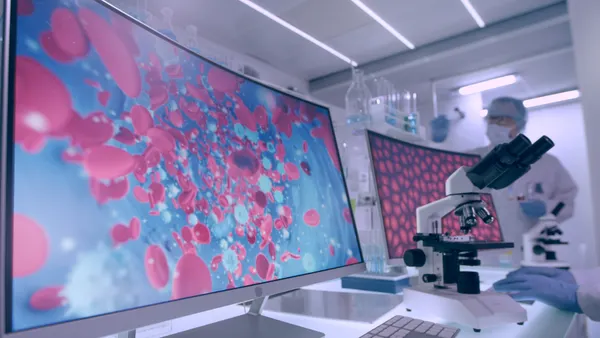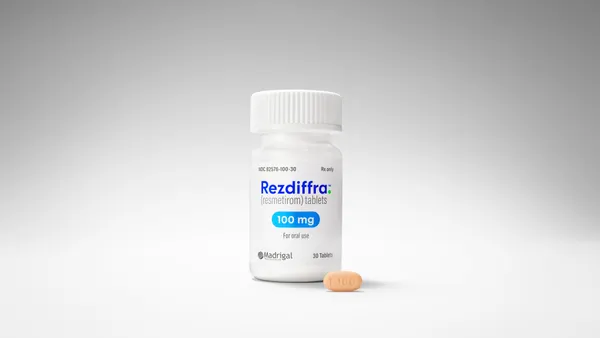58 S e p t e mb e r 2003 PharmaVOICE ALL TOO OFTEN MARKETING AND R&D ARE AT ODDS ON HOW TO BEST ALLOCATE RESOURCES TO SUPPORT THE PIPELINE.THIS DISCONNECT BETWEEN SALES AND SCIENCE THREATENS THE FUTURE OF THE PHARMACEUTICAL INDUSTRY. The GREATDivide IN AN EXCLUSIVETO PHARMAVOICE, MICHAEL MENARD,PRESIDENT OF THE GENSIGHT GROUP INC., DISCUSSES HOW PHARMACEUTICAL COMPANIES CAN OVERCOMETHETURF BATTLES THAT TYPICALLY OCCUR BETWEEN THE MARKETING AND R&D DEPARTMENTSTO CREATE A CULTURE THAT ALLOWS FOR EFFECTIVE DECISIONMAKING ACROSS SILOS. HE PHARMACEUTICAL INDUSTRY IS ONE OF THE MOST COMPLEX INDUSTRIES IN THE WORLD TODAY WITH THE RATE OF CHANGE ACCELERATING ALMOST BEYOND MEASURE. The forces at play range from the emergence of biotechnology to drug affordability and the hazy future of governmentfunded healthcare systems. Despite these challenges, pharmaceutical companies have remained strong financial performers and continue to deliver breakthrough, lifesaving treatments to billions of people across the globe. But whether pharmaceutical companies will be able to maintain their reputation on both the financial and medical fronts is questionable. The “easy wins” are gone, and compa nies can no longer rely on the blockbuster model. According to Michael Menard, this is a symptom of a larger, more dan gerous cultural issue that is ingrained in every pharmaceuti cal company: the division between marketing and R&D. “While the intensity of this division may differ between companies — ranging from a brick wall to a blood feud — it always exists and has a profound impact on business deci sions,” he says. “What’s striking is how significant this divi sion is compared with other industries. There is a stark differ ence between the pharmaceutical industry and, for example, the consumer industry or the telecommunications industry in this regard. This divide just isn’t seen in other industries.” Mr. Menard was at one time a VP of worldwide engineer T 59 PharmaVOICE S e p t e m b e r 20 03 ing for a Fortune 100 company and was responsible for allocating hundreds of millions of dollars to operations all over the world. “There’s no chance that I would have given one cent to a R&D project without knowing whether anyone wanted the product, where it would be sold, or even if it would be prof itable,” he says. “In fact, no quality executive would approve such a state of affairs. Yet this happens every day in one of the strongest U.S. industries.” A Cultural Issue In the pharmaceutical industry, it is not uncommon for marketing and R&D to be completely opposed as to how to allocate resources to support the pipeline. Each group has its own methodology and criteria for these decisions, which in turn has the potential to waste company resources and destroy company value. Those on the technical side of the busi ness can easily fall in love with the science and “follow the molecule.” Those on the marketing and sales side may not be as enamored. “This focus is valuable in the very early stages of discovery,” he says. “Unfortunately, many times what researchers love has little to no true commercial value.” Some companies make no effort to recon cile the marketing and science criteria until the drug is in Phase III trials, Mr. Menard says. At that point companies may find that the drug will do exactly what it was developed to do, but there’s simply no market for the final product. “The research dollars have already been spent and marketing is handed products that no one wants and is told to sell them,” he says. “Then marketers spend another huge chunk of money, even though they know the drug will never achieve the financial goals assigned to the product launch.” Both sides become frustrated, he says. Years of work result in weak sales and a drug is quickly pulled off the market or left unat tended by the salesforce. “This has gone on so long that the bad blood between the groups prevents companies from bridging the gap and having a consistent, agreedupon method for making pipeline and marketing decisions, much less how to allocate resources against those decisions,” Mr. Menard says. “Even worse, the problem is accepted as a fact of doing business.” VIEW on organizational change Mr. Menard says he first experienced this divide a few years ago when his firm was brought in to help a company improve its drug portfolio decisionmaking capabilities. “Though I didn’t know it at the time, both the R&D and marketing departments had made a commitment to developing an improved decisionmaking process including the integration of new technology,” he recalls. “It happened that the R&D folks were moving a little faster than the marketing side, and they had invited us in. “One of the first dimensions we use to assess an individual drug — as well as the overall pipeline — is market attractiveness,” he says. “Those data are used in a scorecard made up of a number of commercial criteria. When we asked for that information we were told by the R&D group they didn’t have it and they couldn’t get it because that information was held tightly by the marketing depart ment. During my initial meeting with mar keting the lack of trust was immediate. They questioned us as to why we needed the data and what we would do with the information.” Why a Divide? The divide, Mr. Menard says, is a serious issue for the pharmaceutical industry. “Although this won’t singlehandedly destroy the industry, the disconnect is one of the top issues companies face,” he says. “It has the clear potential — and already has in some cases — to destroy significant value in compa nies. These are big bets people are making. A bad decision could be a loss of $200 million or more. If companies are wasting those resources, then they’re destroying value.” Mr. Menard says the following factors appear to have contributed to this divide: COMPETITION FOR RESOURCES. In a world of limited resources, business survival depends on outdoing those who are competing for those resources. R&D and marketing are con stantly competing for budget dollars, so in some ways they are natural enemies. “As resources get tighter — and they are getting tighter in every industry — this com petition will get more fierce,” he says. “Com panies are cutting budgets because profit mar gins are down. Within companies, those groups with the resources consider themselves the winners.” THE TWO GROUPS THINK DIFFERENTLY. There is some truth to the typical scientist and marketing executive stereotypes. Indeed, some experts have even made the case that these two groups actually use different parts of the brain for decisionmaking. “Additionally, the way companies are structured can propagate the divide,” Mr. Menard says. “These two major functions get budgeted separately. Budget decisions are made about six months before either group spends the money and does the work. Once the budget is set, decisions are based on old models within their separate worlds.” EARLY REGULATORY POLICIES. A number of senior pharmaceutical executives have said the root of the problem stems from early govern ment regulations that intentionally drove sep Overcoming resistance to that change has become a science. Culture always will prevail over a planned implementation of change. The first step is to understand what the culture is and then change that culture by modeling behavior, by modeling communication, and by modeling the reward system. 60 S e p t e mb e r 2003 PharmaVOICE VIEW on organizational change aration between the technical and commercial sides of the business. Regardless of what created the divide, it has evolved into a systemic organizational and cultural issue facing the entire industry. Both marketing and R&D believe they need to “own” the process because conventional wis dom says that whomever owns the process owns the pipeline. “Both sides know the situation isn’t work ing, but refuse to work toward a solution because they fear losing control,” Mr. Menard says. “They both believe that when they give away information, they’re losing something, when the truth is that only by sharing infor mation can the company gain.” The Way Forward Without merging the external (commer cial) criteria with the internal (technical) crite ria, pharmaceutical companies will never real ize their true potential, and they will continue to send good money after bad investments. This is something they can ill afford as all companies strive to do more with less. Overcoming the turf battles is a Herculean task, but is something that can be done, Mr. Menard says. “A significant change management methodology is required,” he says. “The pro cess must begin by recognizing the problem. Then someone must be responsible for mea suring and then closing the gap.” Mr. Menard says there are four steps that companies should follow to achieve this: 1. ACKNOWLEDGE THE PROBLEM. The first step is to honestly assess whether there is a division between R&D and marketing within the organization. “Unfortunately, those who are aware of the problem are often at too low a level in the organization to fix it, and those who do have the ability to fix it generally aren’t aware of problem,” he says. “Someone at a fairly high level in the company needs to assess to what degree this is an issue for the company and then gain agreement on the need for change.” 2.DEVELOP CRITERIA. Pharmaceutical com panies have tons of data. What they need is relevant information that helps them differen tiate between a good and a bad investment, Mr. Menard says. What is needed is the creation of incisive criteria that cuts through the data fog. These criteria should address the needs of the techni cal and commercial groups. The criteria must then be merged into common scorecards and weighted so that each one is given appropriate importance. In the absence of agreedupon, weighted criteria, it is impossible to differen tiate between investment opportunities. 3. VISUALIZE THE DATA. Now a company must choose which possible drugs should be pursued. If data are presented in a typical spreadsheet format, attempting to compare five or six sets of criteria across as many possi bilities, this will be next to impossible. Certainly this scenario underscores an important element of the complexity theory that says “clear and precise seeing leads to clear and precise thinking.” Recent breakthroughs in data visualization technology allow companies to truly see and understand the big picture, including how current and future projects relate. While the human mind can only hold and consider about three pieces of data at any one time, quality data visualization technology can communi cate up to seven different pieces of data across the total pipeline within one graphic model. These might include market attractiveness, competitive position, strength of patient ben efit and net present value of the investment. Moreover, data are more quickly and easily understood, reducing the time needed to decide which projects to pursue and how to best optimize resources against them. 4. INSTITUTE A DECISION CULTURE. Just knowing the process doesn’t mean that a com pany will be able to make these critical deci sions in the future, Mr. Menard says. “We’ve helped a number of companies establish a new, more effective drug decision making process, and it can be very difficult,” he says. “Even though both sides realize the only way to solve the situation is by merging their criteria, they still want to keep the pro cesses separate. There’s still a fear that, in the end, the other guy could end up `owning’ the process.” Mr. Menard says, to that end, executive leadership — whether that means the boards or the CEOs — has to knock some heads together. They are the only ones with the power to stop the turf war and the ones who ultimately will pay the price if the organiza tion doesn’t improve. Only when the mandate comes from the top and is continuously emphasized (even tying it to performance evaluation) can the divide truly be bridged. In today’s challenging business environ ment, pharmaceutical firms are facing increased scrutiny, demanding investors, and greater external pressures than ever before. Drug development times must be compressed and results must be achieved more quickly. There always will be an element of uncertain ty in the process, but if companies can’t have certainty, they should at least have a unified process to evaluate options and make quality business decisions. F PharmaVoice welcomes commentsabout this article.Email us at [email protected]. a big chunk of senior executives’bonuses and salaries dependent on fixing a problem, they will fix the problem. Things get very serious very quickly.
An article from











